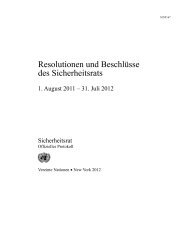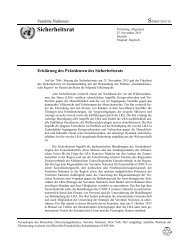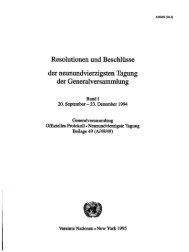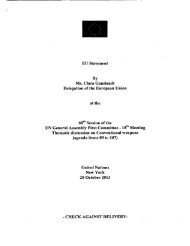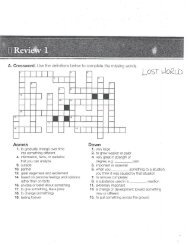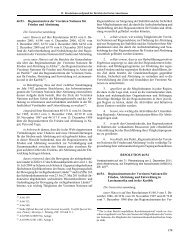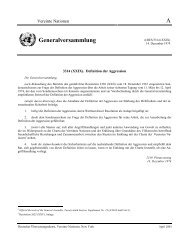IATG 01.80
IATG 01.80
IATG 01.80
You also want an ePaper? Increase the reach of your titles
YUMPU automatically turns print PDFs into web optimized ePapers that Google loves.
2<br />
<strong>IATG</strong> <strong>01.80</strong>:2011[E]<br />
1st Edition (2011-10-01)<br />
d) ‘can’ indicates possibility and capability: It is used for statements of possibility and<br />
capability, whether material, physical or casual.<br />
4 Background<br />
Ammunition and explosives, by their very nature, present an inherent risk during storage and, if not<br />
managed correctly, a latent hazard to local communities in their vicinity. Undesirable explosive<br />
events regularly occur in ammunition storage areas globally, yet much of the resultant negative<br />
impact on local communities would have been preventable if effective risk management systems<br />
had been developed and implemented.<br />
The use of proven and sound explosive science and engineering is therefore essential in<br />
supporting the risk management processes necessary to achieve safe and efficient conventional<br />
ammunition stockpile management.<br />
This <strong>IATG</strong> contains formulae that should be used to support risk management processes within<br />
conventional ammunition stockpile management and summarises their potential use. More<br />
detailed information on the use of each formula is contained within the topic specific <strong>IATG</strong> in the<br />
remainder of the guidelines.<br />
5 Hopkinson-Cranz scaling law<br />
Many States use rules based upon the explosives, their quantity, and the distance from the<br />
explosive to where people are at risk. These rules are known as Quantity-Distance (Q-D) criteria,<br />
and are based on the approach derived from the Hopkinson-Cranz Scaling Law 5 6 , which is further<br />
amended by a range of coefficients. It is the basis of much of the work on the estimation of<br />
appropriate quantity and separation distances.<br />
NOTE 1 It is not always possible to provide the separation distances called for by Q-D, which are worst case, and an<br />
alternative risk analysis system of quantitative risk assessment (QRA) may be used. (See <strong>IATG</strong> 02.20<br />
Quantity and separation distances for detailed information).<br />
The Hopkinson-Cranz Scaling Law is also referred to as the Cube Root Scaling Law:<br />
(R1/R2) = (W1/W2) 1/3<br />
R = Z.W 1/3<br />
Table 1: Hopkinson-Cranz Scaling Law<br />
R = Range (m)<br />
Z = Constant of Proportionality (dependent on acceptable<br />
blast overpressure)<br />
W = Explosive Weight (kg)<br />
Examples of the constant ‘Z’ used in explosive storage safety 7 are shown in Table 2:<br />
Z Purpose Remarks<br />
8.0<br />
14.8<br />
Used to predict separation distances between<br />
ammunition process buildings (APB) within an<br />
explosive storage area (ESA).<br />
Used to predict separation distances between an<br />
explosive storehouse (ESH) and a public traffic route<br />
with civilian access.<br />
� Additionally minimum safe<br />
distances further apply if R is<br />
below a certain level, which<br />
differs for each ‘Z’ function.<br />
5 Hopkinson B, UK Ordnance Board Minutes 13565, 1915.<br />
6 Cranz C, Lehrbuch der Ballistik, Springer-Verlag, Berlin, 1916.<br />
7 These are the default ‘Z’ settings in the <strong>IATG</strong> Software, although the software does allow the user to input alternative ‘Z’<br />
values.



